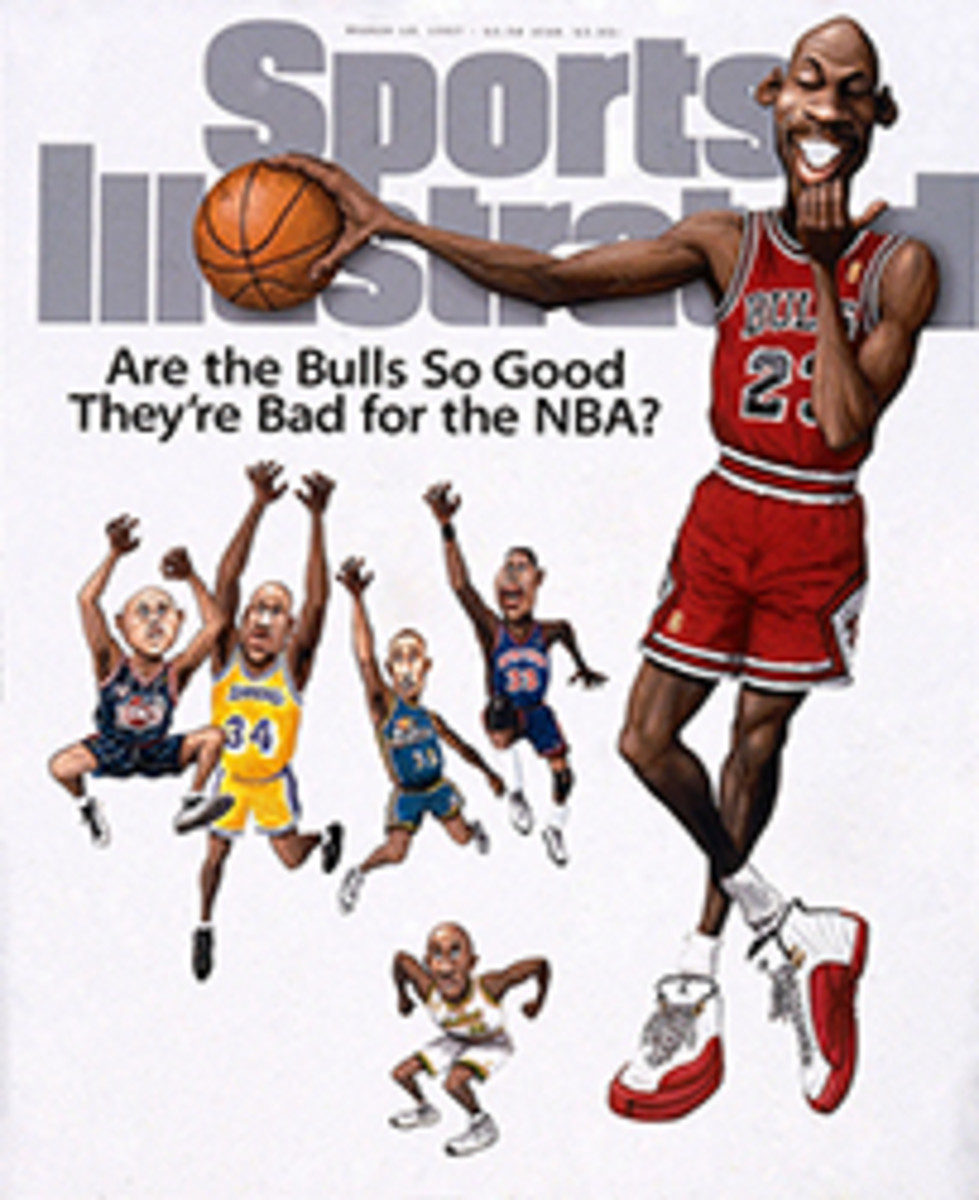
GUESS WHO CAME TO DINNER GEORGIA STATE'S CLEVER PROMOTIONS SHOW HOW COLLEGE GRAPPLING CAN SURVIVE
When Landon Jackson arrived at the Georgia State University
Sports Arena in Atlanta for his team's wrestling match against
visiting Tennessee-Chattanooga on Feb. 1, he was exhausted and
hungry. The day before, Jackson had lost nine pounds to make
weight at 190.
What he found upon entering the arena did nothing to quell the
rumbling in his stomach. The aroma of lasagna was overwhelming.
A piano player in a corner of the gym set the mood for an
elegant dinner. Tables with floral centerpieces had been
positioned alongside the mat. Lights had been dimmed. Candles
flickered.
This was Georgia State's version of Wrestling Dinner Theater, at
which Panthers fans pay $15 apiece to sit matside and watch a
meet while enjoying a full meal, including cheesecake for
dessert--not exactly make-weight dining for calorie-conscious
wrestlers. "I was trying not to think about all that stuff,"
Jackson said later. "I just wanted to get out there and wrestle."
"You've got people here all dressed up, eating, and just a few
feet away guys are rolling around, sweating, bleeding and
beating the hell out of each other," said Todd Lambert, who
redshirted for the Panthers this year and is also sports editor
of the Georgia State newspaper, the Signal. "This is great."
Such quirky moneymakers are not unusual for the Georgia State
wrestling program. "The big schools fund-raise for fun money,"
says second-year Panthers coach Keith Walton, 33. "We do it to
ensure that we're going to stick around."
It's the only way that the lone NCAA Division I wrestling team
in the Deep South can survive. Georgia State's program bucks a
depressing trend in the sport. The team was started in 1991-92,
and according to the NCAA, it was one of perhaps only two new
Division I wrestling programs begun in the past five years. That
would be impressive enough in this era of belt-tightening
throughout collegiate athletics. But college wrestling itself
has been devastated over the last 25 years: More than 250
schools at all NCAA and NAIA levels have dropped varsity
wrestling since 1972, the year that Title IX, which mandates
equal opportunities for men and women in college sports
programs, went into effect.
In creating a wrestling team, Georgia State had a lot of help
from off campus. In fact, there were wrestling boosters before
the school even formed a squad. "We saw that our local boys were
leaving the state [to wrestle in college]," says Gary Jira, the
founding president of the Atlanta Takedown Association. "We just
wanted to give them the chance to stay home."
In the winter of 1990 the association approached Georgia State
athletic director Orby Moss and pledged $60,000 to help fund a
wrestling team. The start-up money came from local businesses
and individual donors. Moss took up the cause, stressing the
fact that wrestling would help balance Georgia State's athletic
programs. In 1992, in fact, the school was rated by the NCAA as
sixth-best nationwide for gender equity at the Division I level.
With the green light from Moss, the Takedown Association took up
its next challenge, which was to find a coach who would quickly
bring credibility to the Georgia State program when it changed
from club status to Division I. The association's members
invited former Iowa coach Gary Kurdelmeier, who happened to be
visiting Atlanta, to advise them. Kurdelmeier's subsequent
hiring to coach the Panthers was as quick a way as any to take
the program to the big time. Kurdelmeier had led the Hawkeyes to
the first two of their 16 national titles, in 1975 and '76. He
was also a former executive director of the USA Wrestling
Association. "I was basically kidnapped off the highway,"
Kurdelmeier says, laughing. "My advice to everybody was to wait
three years. It was terrible wrestling. And I say that now with
all fondness."
Kurdelmeier ignored his own advice and signed on at Georgia
State in the early spring of 1991. Walton, an assistant at
Arizona State who had wrestled at Oklahoma, joined the coach as
an unpaid assistant a year later. He quickly concluded that he
had made a horrible mistake.
"We had to raise money just to get the kids shoes here," Walton
says. "I hadn't bought a pair of [wrestling] shoes for myself
since I was in the seventh grade. Those types of things were
just taken care of. Coming here from those big programs was like
coming to a Third World country."
The payoff came in 1994-95, the Panthers' fourth season, when
the team won the NCAA East Regional and sent four wrestlers to
the national championships. Kurdelmeier retired following that
season and was succeeded as head coach by Walton.
With limited scholarships (the NCAA maximum for wrestling is
9.9) and a modest operating budget of about $100,000, Walton
needs all the help he can get. "I love working out with the
team," he says, "but at the same time I have to figure out how
to put people in the stands and new uniforms on the kids' backs.
I used to just worry about singles, doubles and high-crotches
[takedowns]. When I came here I was just a wrestler. Now I'm a
student of the sport from the marketing end. I want to raise an
interest in my sport."
If collegiate wrestling has attracted much interest lately, it
is primarily because the sport is foundering. The latest
Division I school to eliminate wrestling is Syracuse, which
announced in January that it would drop its 75-year-old program
at the end of this season.
Georgia State, on the other hand, says that it is committed to
the sport. This was a rebuilding year for the Panthers, who
struggled to a 3-9 record in dual meets. (The team's overall
record in duals since its inception is a respectable 52-49.)
Georgia State did shore up its future by signing blue-chip
recruits Ben Iker and Nathan James, both of El Reno (Okla.)
High, and Rufus Baldwin of Lowndes High in Valdosta, Ga. All
three wrestlers are high school state champions.
But the Panthers have few wrestlers who might qualify for this
year's nationals, which take place March 20-22 at Northern Iowa
University in Cedar Falls. Jared Ezzell, who transferred to
Georgia State from North Carolina, is the only remaining NCAA
qualifier from the '94-95 team. Ezzell won the 134-pound East
Regional title that year and was named the tournament's most
outstanding wrestler. But he ran into academic trouble and was
ineligible for the '95-96 season. Now a business management
major, he has made the dean's list with a 4.0 GPA in each of the
past two quarters. He rejoined the wrestling team in December,
has had a 10-1 record and is ranked fifth in the country in his
weight class.
Jackson also figures to go far in the East Regional and,
perhaps, move on to the nationals. His 4-2 sudden-death overtime
win against Pete Herold of Tennessee-Chattanooga was one of the
Panthers' few highlights in their 26-13 loss the night of the
candlelight dinner theater. It was also Jackson's 16th win of
the season, a team high.
After joining his fellow Panthers to help remove the dishes,
glasses and silverware from the tables, Jackson gave in to a
pressing thought. "Everybody here wants to eat," he said,
surveying the gymnasium as if looking for a lost piece of
lasagna. "Cutting weight is just a minor part of wrestling. We
lost, and I'm disappointed, but I'm going to get something to
eat."
COLOR PHOTO: PHOTOGRAPHS BY GREG FOSTER The lasagna was hot, and so was the action, at the Panthers' second candelight dinner meet. [Wrestlers in match]
COLOR PHOTO: PHOTOGRAPHS BY GREG FOSTER At Georgia State, Walton (right) has learned as much about marketing his sport as teaching it. [Keith Walton coaching Georgia State University wrestling team]

